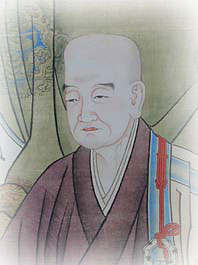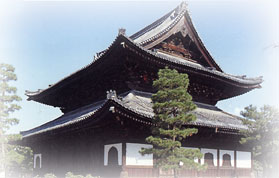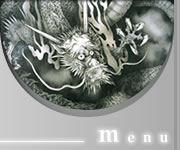
Kennin-ji was established in 1202 upon the request of Emperor Tsuchimikado
土御門 (r. 1198–1210) and with the support of the Kamakura shogun Minamoto
Yoriie 源頼家 (1182–1204), with the Japanese monk Myoan Yosai [Eisai] 明菴榮西
(1141–1215) serving as the founding abbot.
Kennin-ji was first major temple
associated with the Rinzai Zen school to be established in Kyoto; its name
was taken after that of the imperial era at the time it was established.
During Yosai’s abbacy and for a number of generations thereafter the temple
combined Zen with Tendai and Shingon practices, but during the tenure of the
eleventh abbot, Lanxi Daolong 蘭溪道隆 (J. Rankei Doryu; 1213–1278), it was
changed to a purely Zen institution. The temple was originally laid out in
the Zen monastic style with seven principal buildings, but in the
mid-thirteenth century it suffered a succession of fires, and many of the
structures were lost. It was rebuilt by
the great Zen master Enni Ben’en 圓爾辯圓 (1201–1280), but was once again
destroyed by fires during the sixteenth century. In the seventeenth century
donations of buildings by the temples Ankoku-ji 安国寺 and Tofuku-ji 東福寺 helped
restore Kennin-ji to its original appearance. Support by the Toyotomi family
also helped greatly to restore the temple’s fortunes.
 Kennin-ji is ranked third of the Kyoto Five Mountain monasteries. It
presently has fourteen subtemples on the Kennin-ji precincts and about
seventy associated temples throughout Japan.
Kennin-ji is ranked third of the Kyoto Five Mountain monasteries. It
presently has fourteen subtemples on the Kennin-ji precincts and about
seventy associated temples throughout Japan.
Its notable buildings include the Abbot’s Quarters (Hojo; Important Cultural Property), presented to Kennin-ji by Ankoku-ji in 1599; the Dharma Hall (Hatto), built in 1765; a tea house built in 1587 and associated with Toyotomi Hideyoshi; and the Imperial Messenger Gate (Chokushimon), said to date from the Kamakura era (1185–1333), and still showing marks from arrows.


 Kennin-ji was established in 1202 upon the request of Emperor Tsuchimikado
土御門 (r. 1198–1210) and with the support of the Kamakura shogun Minamoto
Yoriie 源頼家 (1182–1204), with the Japanese monk Myoan Yosai [Eisai] 明菴榮西
(1141–1215) serving as the founding abbot.
Kennin-ji was established in 1202 upon the request of Emperor Tsuchimikado
土御門 (r. 1198–1210) and with the support of the Kamakura shogun Minamoto
Yoriie 源頼家 (1182–1204), with the Japanese monk Myoan Yosai [Eisai] 明菴榮西
(1141–1215) serving as the founding abbot.
 Kennin-ji is ranked third of the Kyoto Five Mountain monasteries. It
presently has fourteen subtemples on the Kennin-ji precincts and about
seventy associated temples throughout Japan.
Kennin-ji is ranked third of the Kyoto Five Mountain monasteries. It
presently has fourteen subtemples on the Kennin-ji precincts and about
seventy associated temples throughout Japan.